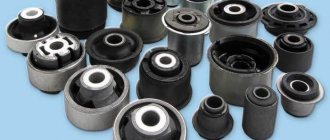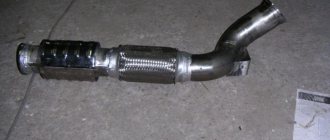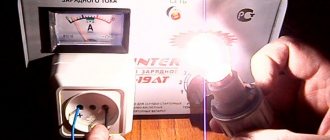Date of publication: October 31, 2021. Category: Automotive equipment.
If it were not for the world's first muffler created by the French company Panhar-Levassor, then perhaps there would be no gasoline cars today. The exhaust system made it possible to “calm down” the internal combustion engine and give this engine a “second life”.
Initially, mufflers performed few functions and were considered more of an auxiliary component rather than important, like other units. However, over time, exhaust systems began to play a more significant role. Today, thanks to mufflers, it is possible not only to significantly reduce the noise level from a running engine, but also to reduce the temperature of the exhaust gases, remove exhaust gases outside the car and reduce the level of harmful emissions into the environment.
Based on this, it is worth paying attention to the structure of the muffler, as well as its varieties.
Why is forward flow needed and why sometimes it needs to be muffled
A car with an exhaust louder than 96 dB will not be able to pass a technical inspection and will not cross the border - in Europe, traffic rules are strict, and the police are incorruptible. Even in motorsports, sound is limited. Only Formula 1 promoters don't like the attempt to drown out the noise from cars. They even opposed the new regulations for the transition from eight-cylinder engines to V6, fearing for the prestige of racing.
Having decided to muffle the forward flow with your own hands, you need to clearly understand the principles of operation of the agreed release, and determine the purpose of the car tuning performed. Improvement in dynamic characteristics occurs only through the installation of a new “spider” - the exhaust manifold. The remaining components of the exhaust system simply should not create resistance to gases and adversely affect the result.
When properly configured, resonant exhaust provides an increase in torque by 3–9% for naturally aspirated engines, and more than 10% for turbocharged engines. But in production cars, the increase in the rate of filling the cylinders with the working mixture during modernization is less than 2–3%.
Installing a direct-flow muffler on regular stock cars is only needed as a decorative option for a pleasant exhaust timbre. The main criterion for the quality of direct flow operation on a production machine is the euphony and velvety noise of the motor, and not the increase in power. The car will scream louder or quieter - this will not affect the speed and dynamic characteristics. In this case, when there is an urgent need to stop the forward flow, you can do this without thinking about the consequences.
Making a muffler with your own hands - stage one
Homemade muffler from a pipe
Before you begin work on making your own model of muffler, you should thoroughly prepare so as not to be distracted in the midst of the process. Everything you need can be found in almost any garage. The main element of the muffler that suffers the most is its body (tank). The thickness of the metal used is too small to withstand repeated overheating, vibration, exposure to moisture and combustion products.
The first step is to find material for the muffler. Practice shows that the best option is the body of an old powder fire extinguisher. The most compact models are metal flasks with a diameter of 100-150 mm, and the body weight will not exceed 3 kg.
The fire extinguisher body has the following advantages:
- Dimensions allow it to be used without modification;
- thick steel will last a long time without destruction, since the body was originally designed to work under high pressure;
- The cone-shaped fire extinguisher neck has thickened metal and requires only minimal alteration.
Fire extinguishers have a limited shelf life, after which or after use, they are written off. Finding one won't be difficult. Carbon dioxide fire extinguishers cannot be used to make mufflers with your own hands, since the smallest model weighs 5 kg. In addition to the body, two pieces of seamless steel pipe with a diameter of about 30 mm are required. The length of the segments is selected in each specific case separately.
A homemade muffler will only work if you have the following tools in your garage or workshop:
- welding machine (preferably semi-automatic);
- angle grinder (grinder) with cutting and cleaning discs;
- sandpaper of different grain sizes;
- paint brush;
- solvent or other solvent;
- heat-resistant paint (KO 811, KO 813 or their analogues);
- workbench with a vice;
- personal protective equipment: welder's mask, face shield, welding and work gloves, overalls, respirator.
Design, principle of operation and types of mufflers
The exhaust system of a car consists of:
- Intake pipe;
- Catalyst;
- Resonator;
- Main muffler.
The exhaust pipe is connected to the exhaust manifold. Its purpose is to combine all the leads from the motor into one cavity. The catalyst neutralizes harmful substances that are part of the exhaust gases. Thanks to this element, the exhaust is not so harmful to the environment.
Next in the system is the resonator. The main task of this element is to dampen the sound of exhaust gases. Externally, it resembles a smaller version of the main muffler.
Muffler materials
All mufflers are made of steel. Manufacturers use different grades of this material to improve the reliability and performance of their products under extreme load conditions.
This part can be made from the following types of steel:
- Carbon;
- Aluminized;
- Aluminum-galvanized;
- Stainless.
Most exhaust system parts are made of aluminum, which means they have a longer service life. Carbon options, on the contrary, fail faster. Stainless steel modifications are less common. However, they are among the most expensive types of mufflers. Direct-flow mufflers are often made from stainless steel, since the temperature of the exhaust gases in such systems is much higher at the end of the line.
Resonator device
The resonator is a flat or round metal can. It has several partitions in which perforated tubes are fixed. They are not installed opposite each other, but offset so that each of them faces the partition.
When exhaust gases enter the cavity from the main pipe, they hit the baffle. By being reflected, they partially dampen the sound wave of the incoming new portion of gases. Then they enter the next chamber of the resonator, where a similar process occurs. At the exit from the resonator, the sound is no longer so intermittent, but more like a hum rather than gunshots.
The flow is directed through the outlet pipe into the muffler tank. Structurally, it is easier to place this element in the rear of the car, since there is more space there.
Muffler device
The muffler itself has a similar structure to the resonator. If you look at it in cross-section, it has similar extinguishing chambers, only larger. In addition to these elements, the muffler may contain an absorber.
This is a special chamber in which perforated pipes pass. It is filled with porous material to absorb sound waves. Metal shavings, mineral wool or other porous material that can withstand high temperatures are used as an absorber.
In fact, there is a wide variety of mufflers. They differ from each other not only in the design of the acoustic chambers, but also in the material from which they are made. According to the type of construction, they are distinguished:
- Restrictive. In such mufflers, the outlet hole is smaller in diameter than the inlet hole. The bottom line is that the pulsating exhaust is extinguished due to the fact that it cannot freely pass through the outlet hole, and therefore spreads throughout the entire cavity of the can.
- Mirrored. In such modifications, exhaust gases hit the partition of the acoustic chamber, are reflected from it and enter a perforated pipe leading to the next chamber. Depending on the part model, there may be more than two such cameras.
- Resonator. These mufflers have up to 4 acoustic chambers. They are connected to each other by a perforated pipe. The sound is dampened due to the fact that sharp jumps are compensated by a large number of outlets along the highway. This design does not allow pressure to be created inside the pipe, which reduces the flow rate.
- Absorbent. The operating principle of such models has already been described a little earlier. This is a modification of the resonator type mufflers, only in addition a non-flammable porous filler is used to absorb sound waves.
Since each design has its own advantages and disadvantages, manufacturers often combine these types of mufflers.
Resonant muffler design
One of the most complex designs is the resonant muffler model. The structure of such models is similar to the structure of a resonator, only the main element has a larger tank with an increased number of acoustic cavities.
Several perforated pipes are placed in the cavity of the can. They are not installed opposite each other, but in different planes, so that the exhaust is dispersed throughout the cavity. Thanks to this, the muffler dampens all frequencies of sound waves. As you would expect, these types of exhaust system elements also create a certain resistance, which affects engine power.
Features of a direct-flow muffler
A feature of all mufflers is that when the temperature and sound effects are eliminated, the engine power partially decreases. A certain resistance is created inside the exhaust system. This factor affects the movement of the piston during the exhaust stroke.
The greater this resistance, the more difficult it is for it to remove combustion products. This means that the crankshaft will rotate at a lower speed. To solve this “problem”, some craftsmen are modernizing exhaust pipes by removing partitions from their cavities. Some people remove the classic muffler altogether and install forward flow.
Naturally, in such models, exhaust gases are removed faster (energy is not wasted on overcoming various barriers). As a result, engine power increases by approximately 7 percent. Even more power can be obtained by removing the catalyst from the system.
Before installing such a muffler in your car, you should remember two things:
- Vehicles whose sound exceeds a certain decibel level cannot be used within the city. A straight-through muffler does not fit into these parameters. A car with such an exhaust system can cause a real commotion in the courtyard of a multi-story building. Such a system can be equipped with a car that drives on tracks.
- If a vehicle's catalytic converter is removed, pollution levels will increase significantly. As a result, the car may not pass technical inspection. Even if a technical inspection is not carried out, taking care of the environment is the task of every inhabitant of the planet, and not individual organizations.
How to make the quietest muffler for a car yourself?
When the issue with noise during car operation has gone too far, and you have decided to make the quietest muffler for the car, then you need to start by preparing the tool. We will need:
- welding machine, an inverter or semi-automatic will do;
- angle grinder and discs for it;
- workbench with a vice.
The surest and most inexpensive way to make a muffler quieter is to weld in an additional resonator. This can be done in a garage yourself.
An additional resonator can be placed between the standard resonator and the muffler. You can install a ready-made resonator; you just need to weld it into the desired place in the pipe. Or you can assemble the resonator yourself. For those who doubt whether the exhaust will become quieter if an additional resonator is welded in, the answer is clear - the exhaust will become quieter. If everything is done correctly.
How to make mufflers quieter?
If you want your car to run quieter, then in this situation you should make some changes to the exhaust system. It is she who is responsible for damping the sound wave generated during engine operation. It should be noted that we are talking about a standard exhaust system and muffler, and not a direct-flow one, since these two systems are quite different. And yet, we will not consider options when the internal structure of the muffler is completely changed and redesigned, a lot of welding work is carried out, etc., here we will talk about the usual methods.
How to change the sound from the muffler to quiet?
There are several simple ways to make your muffler quieter.
To do this, you will need to do one of the following actions, namely:
- install an additional resonator;
- replace the resonator with a new one that has a sound-absorbing filler;
- replace the muffler with a new and high-quality one.
Any of the above options can make the sound of the muffler quieter. It remains to comment on the points, and let's start with the last one.
How is a typical exhaust system integrated into a mid-life gasoline engine?
- Exhaust manifold - collects exhaust gases from the cylinders and directs them into one exhaust pipe
- Short pipe connecting the exhaust manifold to the three-way catalytic converter
- The first lambda probe is a sensor for the percentage of air in the exhaust gases, connected to a computer that controls engine operation.
- Three-way catalyst - catalytic reactions occur in it aimed at the oxidation of carbon oxides and hydrocarbons, as well as the reduction of toxic nitrogen oxides into oxygen and nitrogen
- The second lambda probe is the so-called adjustment
- Exhaust pipe connecting the catalyst to the middle muffler
- Middle muffler - designed to suppress exhaust noise
- Exhaust pipe connecting the middle muffler to the last muffler
- End muffler
- The exhaust pipe that releases exhaust gases from the last muffler into the atmosphere
The location may be more complex on newer vehicles. In its composition you can find more than one catalyst and two lambda probes. The latter, from 2021, also installs a GPF particle filter (Gasoline Particulate Filter).
Empy flue gas consists mainly of nitrogen (about 76 - 78% by volume), oxygen (2-18%),
steam (up to 4%), carbon dioxide (up to 10%), nitrogen oxides (up to 0.5%), hydrocarbons (up to 3%), aldehydes (up to 0.009%) and particulate matter (up to 1.1%).
Ways to muffle the exhaust sound
Before tuning the exhaust system, you need to understand the reasons why the sound of the engine becomes louder over time. The operation of the engine itself is a fairly loud process, but the muffler and other components of the exhaust system perfectly suppress this loud noise. Without a muffler, the engine noise is very loud.
The noise occurs because the fuel mixture explodes in the combustion chamber, releasing gases that then exit into the exhaust pipe. We will not talk in detail about the operation of the engine, you can read about this in another article, but here we will talk specifically about how to muffle the exhaust sound.
The explosion releases energy that pushes the piston, and when the piston has moved the required distance, the exhaust valve opens, through which the exhaust gases exit and go further through the exhaust system. To effectively absorb noise, thick metal parts are used. So, the thicker the metal used in the exhaust system, the quieter the car will drive due to the fact that there will be less vibration.
The exhaust manifold is the first one to absorb the noise, which is why it is made so large and thick, so it best dampens the noise that comes from the cylinder block. Even if you compare the exhaust pipe of any more or less normal foreign car with the exhaust pipe of a domestic car, you can see that in foreign cars the pipe is heavier and thicker, which is why such a car runs quieter.
This is why when you drive an old VAZ 2114, the noise is such that you can’t hear what the passengers in the rear seats are saying, which is why you start thinking about how to muffle the exhaust sound.
The exhaust system also has a resonator, which is needed to reduce the speed of gases through the exhaust pipe. And after the resonator comes a muffler. When exhaust gases pass through the resonator, they lose some energy and continue to flow more slowly.
Gases lose the largest share of their energy in the muffler. If we consider a good muffler, then it contains several separate housings, after passing through which little remains of the noise.
Muffler functions
The muffler is designed to reduce the noise level that occurs during the processing of gases and air and their release into the atmosphere. The second main function of this tool is to convert energy from processed gases, reducing their temperature and reducing their speed.
Several chambers of different sizes, separated by a partition, realize the expansion and contraction of the flow. This happens thanks to the diaphragm hole, also called a throttle.
In addition, the muffler provides for a change in the initial direction of flow of these same processed gases. This is what helps dampen high-frequency sound vibrations.
The design of car mufflers is constantly undergoing changes, although the general principle of operation and the design itself have remained unchanged for many decades. Today this is not an ordinary metal “can” but a full-fledged system that ensures the correct operation of the car engine. That is why, if steam starts coming out of the muffler or popping noises are heard, it is necessary to immediately diagnose and repair this important unit.
Material and manufacturing method
Before you make a muffler with your own hands, you need to decide on the budget and the option for reworking the exhaust system. There are several tuning methods:
- Modification of a new factory muffler.
- Making your own. By the way, you can make a muffler with your own hands using both stainless steel and ordinary steel.
Experts do not recommend using old mufflers or other parts of the exhaust system that have already been used. In this case, even if they look good (after all, they can be repainted before selling), the inside will be covered with corrosion or even burnt out. Remember that with each engine start, the metal in the system heats up and changes its properties. It’s easy to guess what condition a muffler will be in if it’s been used for about 2-3 years on a car. Therefore, do not fall for the tricks of “lightly used” sellers and do not buy a used muffler. Best of all, make it yourself.
A less expensive solution from a financial point of view would be tuning the standard muffler. Making a part with your own hands from stainless steel is a very reliable, but expensive option. However, such an element will be more durable and will not burn out at the most inopportune moment.
Design of the structure and purpose of its components
The parts that make up this design have different functional loads and their own designations, reflecting the stages of their work. The exhaust system diagram itself and the names of its parts look like this:
- exhaust manifold;
- exhaust pipe;
- catalyst or in other words catalytic converter;
- resonator or flame arrester;
- muffler.
The exhaust manifold is an attached type of equipment of the power unit, and is designed to receive exhaust particles and gases of the fuel mixture from the combustion chambers of each cylinder into it, and is made mainly of ceramics, cast iron or stainless steel alloys with increased heat resistance.
Exhaust system design
The downpipe, referred to by car enthusiasts as the “pants” due to its similar appearance, is designed to combine several streams of exhaust gases into one and further transport them to the catalytic converter (catalyst). The pipe is often equipped with a so-called corrugation, which dampens the vibration transmitted to the entire structure of the exhaust system by the running engine.
The catalyst is a ceramic honeycomb, the surface of which is coated with a layer of an alloy of platinum and iridium, which allows exhaust gases to enter into a chemical reaction with them, resulting in their separation into oxygen and nitrogen oxide. The released oxygen in the catalyst helps to burn the remainder of the fuel mixture more efficiently, as a result of which only a nitrogen-dioxide-carbon mixture is supplied to the muffler. The operation of the catalytic converter is monitored by a special lambda probe sensor, transmitting a signal to the control unit of the vehicle's power unit. A similar sensor is installed on the exhaust manifold to analyze the toxicity indicators of the exhaust gases entering the catalyst.
All components of the exhaust system are connected to each other through flanges using fastening bolts and heat-resistant seals, which are responsible for the tightness of this structure, without which the full operation of the engine of a modern car is impossible.
Exhaust system diagram
How to reduce exhaust noise
A sound wave can travel in space much faster than gases, therefore, in the design of a muffler, its noise reduction circuit is of great importance. Physical vibrations from sound waves are transmitted to the walls of the exhaust system, and its design is made in such a way that it converts the sound wave into thermal energy, which the exhaust pipe, like a radiator, releases to the atmosphere.
Reducing the noise level of a muffler cannot be achieved without creating some kind of resistance to the exhaust gases, as a result of which part of the engine power, quite insignificant, is spent on overcoming this resistance. To minimize the power loss that noise reduction inevitably leads to, a direct-flow muffler has been developed.
It has a minimum of partitions, does not interfere so much with the passage of exhaust gases and reduce their speed, which is why it sounds completely different.
Causes of muffler failure:
- High temperature conditions inside the system, about 600 °C. Temperature promotes metal burning;
- As a result of active exposure to the external environment (water, dirt, temperature changes);
We recommend: What is the difference between a strut and a shock absorber?
Exhaust fumes and road surfaces are two of the exhaust pipe's worst enemies.
- The main enemy of a car muffler is low quality fuel, which contains many different impurities. This contributes not only to rapid burnout, but also to contamination of the catalyst, which cleans the exhaust gases of impurities.
- Incorrectly configured ignition system parameters (high CO content).
About direct flow or PG
A direct-flow muffler (PG) is an improved alternative to a stock exhaust, which is not capable of ensuring a quick and timely release of gases from the engine system (ICE). The standard exhaust system especially suffers (chokes) after installing a sports camshaft or after boring the cylinder head cylinders (in other words, on a forced engine).
A straight-through muffler is designed to improve the exhaust system
The GHG is designed to modernize the exhaust system, which increases gas emissions. In addition, a correctly installed PG will provide an increase in internal combustion engine power by 10–15 hp. However, you need to be prepared for drastic changes: everything will need to be replaced, from the catalyst to the tip.
Increasing the power of a power unit using a PG, unfortunately, also has a “other side of the coin”, associated primarily with a loud sound attack of about 120 dB. This is the norm for sports cars, but hardly for civilian ones. And this explains the mass of cases of fines issued by law enforcement inspectors to the owners of such cars.
To minimize this modernization flaw, craftsmen use various methods to reduce sound. Installing a flute muffler, oval or round resonator are all types of methods to improve the performance of a forward flow muffler. “Form and content” can make it quiet.
For example, craftsmen say that a square resonator installed in the middle of the path (the path for gases to escape into the aircraft) reduces noise much better than an oval or round one. And in general, it’s better not to use a round one, but to use an oval one as a last resort, since it has a larger volume of cans and, accordingly, a quieter sound.
Oval resonators from Volvo S60R and Saab have proven themselves to be quite good.
Before thoroughly understanding what GHG is, you should remember the functioning of the vehicle exhaust system. Many motorists do not even suspect how many tasks it performs, although it does not seem so at first glance.
The forward flow kit is a ready-made option for tuning
Of course, the main task of the exhaust is to remove gases. But an equally important function is to ensure timely and high-quality ventilation of the internal combustion engine cylinders.
Ventilation of the cylinders is carried out as follows. When the valves of one cylinder of the internal combustion engine are closed, a vacuum is created in the exhaust manifold. It moves through the system at high speed, and, having been reflected from obstacles, returns to the collector. At the moment the gases leave the cylinder, a reduced pressure is created here, which promotes better ventilation and purge.
Among other things, the exhaust system (ES) is designed to combat noise. This is what the muffler is designed for.
Compared to a conventional standard muffler, the PG does not have many separate sections inside. Accordingly, it has a more simplified design. It is this fact that allows craftsmen to make it at home or in the garage.
But is it even worth it for an ordinary motorist to change the standard muffler to a PG one? Certainly not. If he does not prefer active driving, does not intend to use the car for sporting purposes, does not have complexes about a “gray” car that does not stand out from the general traffic flow, then he should not carry out modernization.
On the contrary, if the bassy and thoroughbred roar of the engine resonates in the soul of the car enthusiast, then the installation of direct flow must be carried out. Moreover, this gives many advantages of the following nature:
- the power of the internal combustion engine increases due to increased throughput;
- The service life of the entire aircraft is extended due to the use of high-quality materials.
As for the disadvantages of modernization, these are:
- problems with the law due to loud noise (can be excluded if the installation of GHGs is carried out using a new system);
- possible difficulties with service maintenance;
- greater sensitivity of the power unit to low temperatures;
- decreased clearance.
Do not confuse forward flow with a muffler. The fact is that the entire exhaust system is called direct flow, and in most cases only part of it is subject to modernization - the muffler.
Devices that set the acoustic parameters of mufflers
Used to reduce individual spectral components of unwanted frequencies in exhaust noise. These components can be used to effectively attenuate sound in certain frequency ranges.
Helmholtz resonator
The Helmholtz resonator consists of a pipe located along the direction of movement of the exhaust gases and a certain volume attached to it (see Fig. “Helmholtz Resonator”). The volume of gas acts as a spring, while the gas contained in the pipe section acts as a mass. At the resonant frequency, this mass and spring system provides a very high degree of sound attenuation in a narrow frequency band. The resonant frequency/depends on the volume V, as well as on the length L and cross-sectional area A of the pipe:
f = c/2π √(A/L V)
Where:
c - speed of sound
Resonators λ/4
The λ/4 resonator includes a pipe, closed on one side, that branches off from the exhaust system. The resonant frequency f of such a resonator depends on the tap length L and is defined as:
f = c/4L
These resonators also provide a high degree of sound attenuation in a narrow frequency band around their resonant frequency.
Exhaust gas dampers
Exhaust gas dampers are most often installed in rear mufflers. Depending on the crankshaft rotation speed or the intensity of the exhaust gas flow, the damper opens or closes the muffler bypass pipe or the second exhaust pipe (see Fig. “Exhaust gas damper controlled by external vacuum”). As a result, exhaust noise levels at low engine speeds can be significantly reduced without loss of power at high engine speeds.
The dampers can be self-regulating depending on the pressure and speed of the exhaust gases or have external control. In the latter case, it is necessary to provide an interface with the engine control system. This makes the system more complex, but at the same time expands its scope.
What is required to build an ASG (direct-flow exhaust system): tuning kit
Undoubtedly, installing a PG is a tuning, a modernization. And everything you need to build such a sporty exhaust option is available in stores.
The first is the resonator. Note that the sports PG does not have partitions that prevent the escape of gases. Its entire design is aimed only at ridding the internal combustion engine of excess gases generated during fuel combustion. As a result, power increases due to increased airflow.
Interesting point. On cars equipped with a naturally aspirated internal combustion engine, installing a sports PG allows you to increase power by 10 percent of the standard power, and on turbocharged cars - by 20 percent or even more.
The second necessary element, of course, is a new direct-flow flame arrester. The universal damper is intended as an alternative to the standard catalyst when constructing a direct flow. Such an element must be made of stainless steel (there is an option of aluminized steel). The internal part of such a flame arrester has a universal design, designed to increase the power of the machine’s power unit.
The structure of the muffler in the form of a diagram gives a complete picture of it
Fastening elements and other accessories, which must include various adapters, adapters, flanges, thermal tape for the exhaust manifold, etc., are also part of the system.
And finally, the muffler pipe, made of stainless steel or aluminized. The pipe itself must have an increased diameter (usually in the range of 38–76 mm). The length of the pipe is about 1000 mm, the wall thickness is 1.5 mm.
About the direct-flow system
Any car muffler reduces engine power by creating significant resistance to the flow of flue gases. This is the price you have to pay for comfort and an almost silent exhaust. But for motorists who are tuning their “iron horses”, there is an alternative option - a direct-flow type sound absorber.
The task of this element is to reduce power losses while continuing to absorb sound vibrations from engine operation. Forward flow is a compromise solution because, for the sake of power, it dampens noise not as effectively as standard car elements. What does this muffler consist of:
- metal body equipped with two pipes;
- inside there is a perforated straight pipe connecting the inlet and outlet;
- Between the body and the pipe there is a sound-absorbing material - kaolin or basalt wool.
Sounds traveling through a straight pipe with holes are partially absorbed by the fiber, but the other part passes out unhindered, because there are no partitions or resonance chambers. Therefore, cars equipped with forward flow make a rumbling sound, especially when you press the accelerator pedal.
The highest level of tuning is a combined exhaust system with a damper controlled from inside the car. With its help, the gas flow can be switched between two branches: the first has a conventional effective muffler, and the second has a forward flow. This allows you to use the power of the engine only when necessary, and under normal conditions, drive around the city without unnecessary “roar” from the exhaust pipe.
Car muffler diagrams
A cross-section of a car muffler allows you to see exactly how the sound reduction function is implemented in each specific muffler. In direct-flow mufflers, for example, the method of changing the direction of gas movement is never used, and a standard muffler uses turns from 90 to 360 degrees. The change in the amplitude of sound wave oscillations is realized by perforating the internal pipes. It is these internal pipes, their diameter, diameter and frequency of holes that can drown out noise in almost the entire frequency spectrum.
But only the integrated use of these methods can guarantee high efficiency of the entire exhaust system as a whole. Therefore, modern cars use from one to six different mufflers. The main ones are the resonator and the main muffler.
Sectional view of muffler
Let's see a cross-section of the car muffler device in this photo,
Here we see the required elements of a muffler or, so to speak, what a car muffler consists of:
- Exhaust manifold (popularly called pants or spider for its similarity in design)
- Flame arrestor or resonator
- Connecting pipes between muffler chambers
- Muffler main frame
- And the exhaust pipe itself
- The exhaust manifold is pipes that are directly attached to the engine terminals to actively draw exhaust gases directly from the vehicle's cylinders, so temperatures at the junction of the manifold and the engine can reach values of 1000 degrees Celsius
- Therefore, the requirement for the exhaust manifold is always high: the required thermal stability of the material and strength in relation to mechanical loads, which is why the manifold is often made of cast iron or heat-resistant steel.
- The muffler resonator is usually a pipe with holes drilled in it of different diameters, which is located in a closed chamber due to the expansion and release of gases through the holes of this pipe and they resonate, essentially damping the vibrations and changing the oscillatory circuit of the sound wave
- The main muffler is essentially like a multi-room apartment, only the rooms are not connected there by doors or hollow pipes, and sometimes in order to get into another room, exhaust gases have to pass through pipes from other rooms back and forth several times - this is done to extinguish the energy of the gas and convert it into heat energy, because of this energy conversion the sound wave decreases
Well, I think that we have answered the question of the muffler in a car, its purpose and structure, and now you have at least an idea of its structure.
Why is a homemade element better than a factory one?
Due to the large number of fakes, it is very difficult to find a truly high-quality spare part today. And if such a part is found, the price for it will be simply exorbitant. Moreover, most of the complaints concern the elements of the exhaust systems. The muffler rusts and burns out very quickly. Its service life does not exceed 1-2 years. It doesn’t matter how intensively you use your car. It burns out not from mileage, but from time. Even if the car is driven once a week, this will not add life to the muffler. It will still have to be changed in a year or two.
After this time, car enthusiasts have a question about the need to replace or repair this part. If you repair the muffler yourself or make it from scratch, you can be sure that it will last much longer. After all, we will not skimp on important materials. Also, by making a muffler with your own hands, you can add your own configuration to the exhaust system. For example, make a forward flow to increase engine power. However, driving long distances with such a “can” will be uncomfortable. Therefore, you can remake the system in a different way by adding an additional resonator to it. This way the machine will run much quieter.
How to get a straight-through muffler
You decided to make a bassy exhaust with your own hands. The first thing that is required is to convert the structure to a direct-flow one. The work takes place in three stages:
- dismantling the old muffler;
- preparation of the design basis;
- installation of direct flow and installation of insulation.
Removing elements of the old exhaust system
Carefully remove the muffler that is installed in the vehicle. It will probably be in a standard version, which guarantees a balance of power, sound, isolation - manufacturers rarely equip regular (non-sports) vehicles with anything else. Study the design of the exhaust system and think about how best to modify it to suit your needs.
Preparing the base for forward flow
You will still need the old muffler. Cut out its body and open it, then remove the internal filling. It is this that prevents you from getting that “roar” when driving at high speed, since it performs an isolating function.
Next, proceed to welding work. First, connect the old pipe with a new one purchased in advance. It is very important to choose a pipe with a diameter of about 20 cm. The increased diameter will allow a larger volume of exhaust gases to pass through its cavity, and this is what makes the sound booming. The new element should be welded into the housing remaining from the removed old exhaust system element.
Please note: visually the structure should look the same as before before dismantling. Otherwise, you will have problems securing the structure to the bottom. In the future, if you get into tuning at a professional level, there will be more opportunities for experimentation. The main material should be strong, heat-resistant steel - the temperature of the gases is very high and can damage a low-quality product made of thin steel.
Before moving on to how to make a bassy exhaust, take care of the appearance of the protruding part of the pipe. Many car owners find it unaesthetic. If you are one of them, use special attachments - they are sold in specialized stores.
Laying insulation
In order for the sound to be powerful, and the machine components located in the bottom area not to overheat due to the new pipe, it is necessary to use heat-resistant insulation. It is tightly wrapped around the welded structure, avoiding gaps. The following rule applies: the denser the insulation, the more growling the exhaust sound becomes. The insulation is additionally protected on top with a thin layer of stainless steel, and then tightened with steel clamps. The finished structure can be returned to the main place of work.
The muffler is broken
The exhaust system of a car is the most unprotected part of the car. It is exposed to external influences and car enthusiasts often have to repair it. A breakdown of the system is not just an unpleasant knocking sound and other “delights” such as a decrease in car power, jerking of the car, but also the danger that toxic fumes coming out of the engine can leak into the cabin and poison people. In order for your exhaust system to function properly, it, in particular, and the car in general, must be systematically checked and taken for maintenance. If you neglect this, you risk getting into an accident at the most inopportune moment. Don't forget that muffler damage is on the list of ten reasons why you have to call a tow truck.
Corrosion protection
The muffler often suffers from fading of paint, which is why corrosion quickly renders it inoperable. One of the effective ways to protect the surface of the exhaust system from corrosion is to paint it. It should always be remembered that the temperature of the gases leaving the exhaust pipe is usually 420–760 °C, and the surface temperature of the exhaust pipe is 200–540 °C. Therefore, only heat-resistant, silicone varnishes and enamels are suitable for painting.
To paint the “glushak”, you need to proceed like this:
- First, remove the muffler and prepare it for painting (to do this, you need to thoroughly clean it of all dirt and oil, degrease it and dry it well).
- Inspect the dried muffler, not missing any areas where the factory coating has peeled off or oil stains.
- If you do find oil stains, take a rag soaked in gasoline and wipe them thoroughly.
With peeling factory paint, proceed as follows:
- Take a strong knife or putty knife and remove the previous coating.
- If you notice rust on the exhaust system, remove it immediately using coarse sandpaper or a special rust remover.
- After these manipulations, apply a layer of primer.
- After the primer has completely dried, paint as stated in the instructions for the paint you purchased.
- Then let the muffler dry a little, install it back under the car body and let the engine run for a few minutes so that the muffler warms up and the paint dries.
There are times when the rust has penetrated too deeply and it is impossible to get rid of it. If this is your option, then you should treat the muffler with a rust converter.
There are alternative ways to protect the exhaust system:
- First you need, as for painting, to clean the muffler and exhaust pipe from dirt, oil and rust, and then apply a thin layer of graphite lubricant. You can do it as follows:
- Let's go to the nearest computer store.
- We ask them to process the powder from the printer.
- Mix it with a small amount of grease.
- Then you need to coat the surface with the mixture, place it on stands and start drying with a hair dryer, blowing from the side of the resonator.
We recommend: Shelf life of engine oil in the canister and engine
Until the grease completely burns out, the coating will not stop emitting a pungent odor, so carry out all manipulations in a respirator and outside, or at least in a well-ventilated room (garage).
The muffler is leaking
You carried out an inspection and found no signs of corrosion on the muffler, but saw damage. Unfortunately, this happens, because the exhaust system is the most unprotected part of the car; it is affected by both mechanical influences (for example, a bouncing stone or unsuccessful parking of a car) and chemical ones, in the form of aggressive chemical compounds, salts and even the external environment. But there are also obvious reasons for the formation of a hole: perhaps the muffler is made of poor quality material.
Muffler burnout
If you are faced with such a nuisance as a muffler burning out, then do not rush to think that the problem lies inside the car. Novice car enthusiasts believe that mufflers burn out due to too intense exhaust emissions created by the internal combustion engine. But often this is not the case. Today, many car manufacturers, even well-known brands, produce cars with low-quality parts, without normal processing, which are highly susceptible to chemicals and the environment.
Example of a burned out muffler
Obviously, the main reason for system burnout is various types of environmental influences on the part. If you treat your car irresponsibly, it is stored in rain, snow or scorching sun, then you should not be surprised that part of the exhaust system quickly burns out, because this is facilitated by a natural chemical process in this case - metal oxidation.
Another common reason for part damage is idling the car and driving short distances. Do not forget that sudden temperature changes are detrimental to the muffler. At low temperatures, condensation forms in the muffler, which has a destructive effect on all metal except stainless steel.
What is a flute in a direct-flow muffler, and what is its effect?
To make the forward flow quieter and get “passing” decibels at the output, a simple design is used, which motorists call a flute. This is a piece of perforated tube with a length of 180–250 mm and a diameter of slightly more than 1/3 of the exhaust, with a welded plug washer in the form of a disk, cylinder or cone, which is bolted inside the forward flow, at the air cut, thereby allowing it to be muffled.
The principle of operation of the flute for direct flow is that when the cross-section of the exhaust channel changes and exhaust gases exit through the perforations, the following occurs:
- change in speed and pressure;
- the sound wave breaks;
- the volume decreases by 3-4 dB, the exhaust becomes quieter.
The correct name for this flute is silencer (from the English silencer - muffler), and it is included in the set of expensive exhaust systems that are sold on the Internet. You can also purchase separately, the average price of good European models is 70–150 dollars, and mass ones from the Middle Kingdom - from 450 rubles.
Adviсe
In order to reduce the noise of a homemade muffler, it is recommended to fill its body with some material such as glass wool. It is also recommended to make a condensate drain hole at the bottom of the muffler. Thus, it will not rust prematurely and make extraneous noise.
If this is a muffler made with your own hands from stainless steel, it is important to think through its design. Make it partially collapsible. This way you will periodically clean the pipe cavities from dirt and change the filler if necessary. Thanks to the collapsible design, the service life of the part will increase several times. Do-it-yourself installation and replacement of the muffler is done in standard places. The main thing is to strengthen them, since the weight of the structure increases slightly.
Homemade muffler for a car requires finishing work
The exhaust system of a car is constantly exposed to processes that actively contribute to corrosion and destruction. Moreover, the place under the bottom of the car is not the cleanest. For this reason, many car enthusiasts do not pay attention to the cleanliness of the exhaust pipe, but since we have dared to make it with our own hands, it is necessary to give it a marketable appearance. This will help protect the metal from destruction, and you can safely show it to your friends.
The muffler receives its commercial appearance after the following manipulations:
- welding seams are cleaned with a grinder;
- the body and pipe are sanded with sandpaper;
- the outer surface is degreased and cleaned with a rag soaked in solvent;
- The muffler is painted with a brush in 2-3 layers of special heat-resistant paint.
When choosing a paint, you must make sure that it can withstand temperatures up to 600°C. Otherwise, there is a high probability of it burning and peeling. All. The homemade muffler is ready and, believe me, it will serve you faithfully for a long time.
How to repair a muffler with your own hands without welding?
Now there is a new method for restoring the performance of exhaust system parts using a universal composite polymer (various sealants). Thanks to their special composition, they harden quickly and are not subject to external negative influences, including high temperature changes, which is very important for the exhaust system. In car markets you can find two types of sealants, thanks to which you can repair the muffler yourself without welding:
- Plastic.
- Liquid.
In combination with high-quality reinforcing components, these types of sealants will create a reliable “patch” on the burnt-out section of the muffler. Car enthusiasts note the effectiveness of plastic elements. It is these sealants that are characterized by high adhesion to metal, even if there is rust on it.
Traffic fumes
During operation, various vehicle systems (internal combustion engine, fuel, ventilation, and chassis) emit harmful substances in the form of gas and fine dust. Some of them are non-toxic compounds that are found in ordinary air. The other part is poisonous, toxic and carcinogenic substances, which not only negatively affect the environment, but also destroy human health.
Main pollutants:
- CO
(also known as carbon monoxide, or carbon monoxide) is colorless and odorless, but leads to pathology of the central nervous system, depression of the cardiovascular and respiratory systems, and in a concentration of 0.3% of the volume of air is fatal. It occurs as a result of incomplete combustion of fuel. - CH
(hydrocarbons) are a large group of compounds with a common structure that arise when fuel is burned incompletely or not quickly enough. These include paraffin, olefin, aldehyde, formaldehyde, benzene, toluene, xylene and other polycyclic compounds. These mutagens and carcinogens destroy the respiratory system and promote the growth and development of cancer cells, including blood cancer - leukemia. - NOx
(nitrogen oxides) is the main cause of acid rain, since when combined with water, nitric and nitrous acids are formed. It is one of the serious carcinogens that causes cancer. The toxic gas destroys the respiratory system and accumulates in the blood. Formed during fuel combustion. - SOx
(sulfur oxides) is similar to the previous chemical element. On contact with water they form sulfuric and sulfurous acids. In a gas state it causes pathologies of the organs of vision and breathing. - H2S
(hydrogen sulfide) - causes general poisoning of the body, occurs when using low-quality fuel with a high sulfur content. - NH3
– ammonia – causes blindness and burns of the upper respiratory tract. - Soot particles are a product of incomplete combustion of fuel and oil.
Basically, the problem of carcinogen occurrence is typical for diesel engines. - Fine dust particles of hydrocarbons, sulfur, and heavy metals
are less dangerous, since they can be filtered directly by the body. - Blue or white smoke
is a product of evaporation of diesel engine oil. - CO2
- carbon dioxide - causes depression of the central nervous system, cardiovascular system and respiratory organs, and when contained in the atmosphere at 6% of the total air volume, it leads to death. - Other, minor, but no less dangerous components of exhaust gases
: methane, nitrous oxide, hydrofluorocarbons, sulfur hexafluoride.
In modern legislation, the problem of ecology and the standards of maximum permissible exhaust gases for motor vehicles are regulated by the technical regulations of the Customs Union TR CU 018/2011 as amended on July 11, 2016. However, from November 11, 2021, amendments will be made to it, but for now the following limit values are allowed: CO - 85 g/kWh, HC - 5 g/kWh, NO - 17 g/kWh.
And mandatory vehicle components include exhaust gas aftertreatment systems, including replacement catalytic converters (with the exception of urea-based aftertreatment systems).
Details on how to make a homemade muffler
How to weld a homemade muffler for a VAZ 2101
The manufacturing process begins with dismantling the exhaust pipe. You will have to remove it in order to cut off the old muffler. Next, the pipe should be installed in place (without tightening the fasteners). This is necessary for further fittings. We will also borrow brackets from the old body, with which it is attached to the body, or we will make them anew. Drawings for a homemade muffler can be found in specialized literature, or it is better to draw up your own, based on the following conditions:
- the inlet pipe to the muffler is located along the body (enters the rear part of the fire extinguisher), offset from the center to the side wall and immersed inside 2/3 of the length of the body;
- The outlet pipe from the muffler is located along the axis of the body (the upper part of the fire extinguisher) and is also immersed inside 2/3 of the length of the body.
Thus, inside the housing, the pipe cuts overlap each other, but do not collide due to axial displacement. Before direct assembly, it is necessary to refine the workpieces:
- the fire extinguisher is emptied, the shut-off valve is unscrewed from it;
- using a grinder and welding machine, a hole corresponding to the diameter of the pipe is made in the upper part;
- the same hole is made in the bottom of the fire extinguisher body, but shifted towards the wall of the body;
- in the body of the pipe sections that are placed inside the body, cuts are made with a grinder disk in a checkerboard pattern (20-30 pieces each). You can drill holes, but this will require a drill press.
After this, you can proceed to the first fitting. The body of the future muffler is suspended in its regular place, first secured with improvised means (the fire extinguisher is positioned bottom forward of the car). Pipe sections are inserted into the holes. Next, the housing must be rotated until the inlet hole has the most convenient coincidence with the standard pipe.
Having aligned all the parts as they will be, you can “grab” them by welding. After this, the muffler is removed and the pipes are finally welded to the body. The manufacture of mufflers is a responsible procedure, so it is better to entrust welding work to an experienced specialist. Brackets are also welded to the body. At the last fitting, you can cut the inlet pipe and weld it to the main one, and cut the outlet so that it protrudes slightly beyond the edge of the bumper.
Homemade muffler with a pleasant sound
I don’t know how it is now, but many people used to know that an old car fire extinguisher is an excellent preparation for direct flow.
The story is simple: what I didn’t do with the original muffler can on the pita was of little use. I changed the muffler stuffing, made a flute like a Yamaha one, but still the sound was disgusting, rattling and loud, in general - a barrel organ.
It is possible to install a full-fledged direct flow from the pit, but you need to shorten it, digest the fasteners, but you understand: there was no particular desire to buy a barrel for 5 rubles and still digest it all, but the desire to get rid of the original muffler still did not leave.
And so back to the fire extinguisher. One was lying gathering dust in the garage a long time ago, but to make a direct flow you need two... And so, one fine May morning, on a small river, among the snags on the surface, the desired second fire extinguisher was spotted. Exactly the same as the first one, and now there were two of them. Well, you yourself understand what this led to.
In general, let's go)))
We take the most attractive tool in the garage, affectionately called “Binder,” and saw the bottoms of the fire extinguishers evenly.
Next, take a forty pipe, cut the gas distribution slots with a grinder, or, if you’re not too lazy, drill a billion holes. Then we weld one end of the pipe to the part of the muffler where the outlet will be.
You don’t even need to do anything with the outlet hole: the mounting location for the fire extinguisher spray is just perfect and the diameter is just right.
Now we stomp into the kitchen and tear open the casing of the ZIL refrigerator, tearing out the glass wool from there. Just wear thick clothing and gloves when working with glass wool, otherwise you will itch for two days, and if during these two days you want to relieve yourself, then... yes, it will itch there too... In general, we take glass wool and stuff the outlet part of the jar as tightly as possible.
Then we proceed to the entrance part. The thread in it needs to be cut so that the magpie pipe passes through, and, of course, we also fill it with glass wool, the denser the better.
Well, well, the only thing left to do is weld both parts together and weld the pipe to fit it with the standard muffler.
I didn’t bother with the fastenings to the frame, and why should I? I made two points of attachment to the luggage frames (it couldn’t be stronger): this fastening withstood a revolution on the asphalt and the can became a junk)))
The end of the jar is at your own discretion. I made pipes of a smaller diameter, and it looks quite good)
The sound, let me tell you, turned out surprisingly great! Even though it’s forward flow! At idle you can’t hear it at all, even the electronics are louder, but when driving it’s just the most beautiful sound - a soft growl without a dull metallic rumble and yelling.
Well, here’s the final look) The plastic doesn’t burn, the sound is pleasant, nothing was done to the original pipe. What else does?)))
Do-it-yourself muffler repair using electric welding
To weld a muffler yourself, you only need to have a little skill in working with metalworking. The work can be done in any garage conditions. Penetrating corrosion must be completely cut out using an angle or straight grinder using a cutter.
Depending on the diameter of the defect, the work can be done in two ways. The first is to apply a patch, followed by welding it around the perimeter. This method is used for large defects or a large accumulation of pores in one place.
The second method allows welding without the use of patches, in which through holes are fused directly by an electric arc. This method is applicable only if the corrosion or defect is small. It will not be difficult to patch such holes either with an electrode, using simple welding, or with copper wire, when working on a semi-automatic machine.
Most often you encounter corrosion in the place where the muffler body and pipe are connected. After cleaning and removing rust, the gap between these parts increases significantly. You can increase the required thickness between them using a filler wire (electrode) or weld using pieces of prepared sheet metal. After applying the metal sheet, it should be grabbed, ensuring its fixation with the muffler body, and then proceed to the main welding.
Upon completion of the work, the heat-affected area and the weld itself should be painted over with paint. This treatment will protect the metal from corrosion and prolong the service life of the part. Before painting, do not forget to clean the seam from scale with a wire brush and degrease its surface. It should be remembered that not every paint is suitable for the muffler. For painting, choose heat-resistant paints or mastic.
Catalytic converter for exhaust gases in the exhaust system
Exhaust system VAZ 2114 injector 8 valves
The catalytic converter consists of an inlet funnel, an outlet funnel and a monolith (see figure "Catalytic Converter with Ceramic Monolith"). The monolith contains a large number of very thin, parallel channels coated with an active catalyst. The channel density ranges from 60 to 190 cells per square meter. see. The operating principle of the active catalytic layer is described below (see “Catalytic exhaust gas purification”).
The monolith can be a metal or ceramic material.
Metal monolithic block
The monolithic metal block is made of corrugated metal foil 0.05 mm thick, which is wound and soldered with hard solder at high temperatures. Thanks to the very thin walls between the channels, the monolithic metal block offers extremely low resistance to the exhaust gases. This property is often used on cars with high-power engines. A monolithic metal block can be welded directly to the funnels.
Ceramic monolithic block
The ceramic monolithic block is made on the basis of cordierite. Depending on the cell density, the wall thickness between the channels ranges from 0.05 mm (at a density of 190 cells/sq. cm) to 0.16 mm (at a density of 60 cells/sq. cm).
Ceramic monolithic blocks are extremely resistant to high temperatures and thermal shock. However, they cannot be installed directly in a metal housing and require special fastenings. These fasteners are necessary to compensate for the different coefficients of thermal expansion of steel and ceramic, and protect the sensitive monolithic block from impact
Extreme care and attention is required during the production process, especially with thin-walled monolithic blocks (The mounting mat is made of ceramic fiber. It has high elasticity, which is necessary to minimize mechanical stress on the monolithic block
The mounting mat also serves as a heat insulator.
One catalytic converter can contain several monolithic blocks with different coatings. To ensure uniform passage of exhaust gases through the monolithic block, special attention should be paid to the shape of the inlet funnel. The external shape of the ceramic monolithic
The block depends on the space under the car body and can be triangular, oval or round.
Why does the exhaust system make loud noises?
To understand the reason for the appearance of loud sounds, you need to know the principle of operation of a standard exhaust system and the loads it is subjected to during operation. Temperature changes (cold and heat), contact with moisture, dirt and dust - all this provokes the development of corrosion. After some time, sections of pipes with perforations and those parts of the partitions that are located inside the muffler can burn out. Sound reflectors are gradually becoming unusable. In especially difficult cases, only one thing can save you from a loud exhaust system - replacing the old muffler with a new one.
Where do loud noises come from in the exhaust structure? They have different origins. Firstly, these are sounds from the expansion of gases that pass through it. Secondly, there is noise caused by vibration of exhaust components.
Traffic fumes
Main pollutants:
- CO
(also known as carbon monoxide, or carbon monoxide) is colorless and odorless, but leads to pathology of the central nervous system, depression of the cardiovascular and respiratory systems, and in a concentration of 0.3% of the volume of air is fatal. It occurs as a result of incomplete combustion of fuel. - CH
(hydrocarbons) are a large group of compounds with a common structure that arise when fuel is burned incompletely or not quickly enough. These include paraffin, olefin, aldehyde, formaldehyde, benzene, toluene, xylene and other polycyclic compounds. These mutagens and carcinogens destroy the respiratory system and promote the growth and development of cancer cells, including blood cancer - leukemia. - NOx
(nitrogen oxides) is the main cause of acid rain, since when combined with water, nitric and nitrous acids are formed. It is one of the serious carcinogens that causes cancer. The toxic gas destroys the respiratory system and accumulates in the blood. Formed during fuel combustion. - SOx
(sulfur oxides) is similar to the previous chemical element. On contact with water they form sulfuric and sulfurous acids. In a gas state it causes pathologies of the organs of vision and breathing. - H2S
(hydrogen sulfide) - causes general poisoning of the body, occurs when using low-quality fuel with a high sulfur content. - NH3
– ammonia – causes blindness and burns of the upper respiratory tract. - Soot particles are a product of incomplete combustion of fuel and oil.
Basically, the problem of carcinogen occurrence is typical for diesel engines. - Fine dust particles of hydrocarbons, sulfur, and heavy metals
are less dangerous, since they can be filtered directly by the body. - Blue or white smoke
is a product of evaporation of diesel engine oil. - CO2
- carbon dioxide - causes depression of the central nervous system, cardiovascular system and respiratory organs, and when contained in the atmosphere at 6% of the total air volume, it leads to death. - Other, minor, but no less dangerous components of exhaust gases
: methane, nitrous oxide, hydrofluorocarbons, sulfur hexafluoride.
Preventive measures
You can extend the life of the muffler by systematically caring for it, performing timely washing and treating it with anti-corrosion compounds. In addition, for preventive purposes, you can use a corrugated pipe, securing it between the manifold and the body of the part. Such a coupling will be able to absorb excess vibrations, reducing friction and the operating temperature of the muffler.
Sources
- https://ZnanieAvto.ru/gazy/kak-sdelat-pryamotok-tishe.html
- https://cartore.ru/2768-izgotovlenie-glushiteljami-svoimi-rukami.html
- https://avto-cool.com/remont-avtomobiley/kak-umenshit-zvuk-glushitelya-v-avtomobile-svoimi-rukami
- https://vyhlopnie-systemi.com.ua/ru/remont-vihlopnih/kak-sdelat-glushiteli-tishe/
- https://www.syl.ru/article/198000/new_kak-sdelat-glushitel-svoimi-rukami-remont-glushitelya-svoimi-rukami-bez-svarki
- https://ladamaster.com/ustroystvo-glushitelya-avtomobilya-v-ra
- https://pol-z.ru/kak-sdelat-pryamotok-svoimi-rukami/
- https://master-glushiteley.ru/articles/tuning_articles/basistyj-vyhlop/
- https://svarkaprosto.ru/tehnologii/kak-zavarit-glushitel-elektrosvarkoj-samostoyatelno
- https://master-glushiteley.ru/articles/tuning_articles/kak_sdelat_glushitel_tishe/











